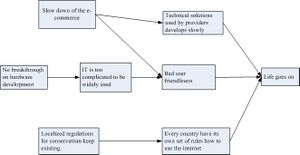Scenario 2: bottom-up Internet
Life goes on
In this scenario of the future of the bottom-up Internet there are no real strong outside forces that influence the future and no major technical breakthroughs will place. Scenario by Jim, timeline by Andrew.
2006 - 2011
The internet will just continue to grow until most of the population around the world is connected just as with the telephone. During this period no really essential breakthroughs are made. The next six years the connection speed of the internet will be scaled upwards so that it becomes normal to have a 10 mbit line. Software will continue to grow towards containing more web enabled features like live office suites personal location tracking and continued developments towards live internet bootable operating systems.
Hardware systems will also improve, computers will become faster, storage solutions like holographic storage are taking off and flexible sceens and micro cameras will all get introduced.
The e-commerce community will first grow a lot because of the “ICT accustomed society”, but in time it will slow down because less and less new applications of the internet are found and already existing players try to keep their market share. At that point in time the big players are struggling with developing new moneymaking applications and budgets become tighter. This means that less money can be spent on developing new solutions and that mostly existing solutions are improved. In effect this will also improve the user friendliness.
Because around 2010 there are no more essential breakthroughs in software and hardware development the focus can shift from creating innovative solutions to providing user friendliness. Only real IT specialists can develop software and when in the end the e-commerce growth slows down they will focus on user friendliness.
The bottom-up internet will continue to grow at the same pace e-commerce grows, but when in the end the growth of e-commerce slows down the bottom up internet seems to win some ground. Especially in the region of open source software and content provision. This is mainly because most bottom-up solutions have always been aimed at providing as much user friendliness as possible.
Because the e-commerce growth first goes very quickly some goverments and users feel threatened and new regulations are made by governments all over the world. Some more strict than others but all restricting data gathering within certain limits.
Summarized could be said that this scenario actually states that development of the bottom-up internet will just develop as the internet does, but in the end it will gain more ground.
